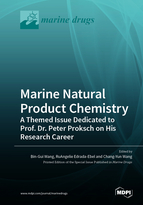Marine Natural Product Chemistry: A Themed Issue Dedicated to Prof. Dr. Peter Proksch on His Research Career
A special issue of Marine Drugs (ISSN 1660-3397).
Deadline for manuscript submissions: closed (15 November 2021) | Viewed by 61365
Special Issue Editors
Interests: natural product chemistry; bioactive compounds; drug discovery; structure determination
Special Issues, Collections and Topics in MDPI journals
Interests: marine natural products chemistry; secondary metabolomics; NMR- and MS-based metabolomics; marine biotechnology
Special Issues, Collections and Topics in MDPI journals
Interests: marine natural products; isolation and structural confirmation; bioactivity; lead compounds; marine fungi
Special Issues, Collections and Topics in MDPI journals
Special Issue Information
Dear colleagues,
Prof. Dr. Peter Proksch is a distinguished and internationally known natural product chemist who devoted most of his professional career studying marine natural products derived from benthic macro-organisms, mainly sponges, molluscs and tunicates, and from fungi as well. His research interests focus on structure elucidation and mode of action of new bioactive metabolites with potential application in pharmaceutical sciences and in agriculture, on chemical ecology and natural functions of secondary metabolites as well as on co-cultivation techniques to activate silent biogenetic gene clusters of microorganisms to biosynthesize novel bioactive metabolites. Co-cultivation of micro-organisms relies on microbial crosstalk, which could induce the expression of cryptic natural products and/or strongly enhanced accumulation of constitutively present metabolites when compared to axenic microbial cultures.
Representative examples of his research findings include:
- The discovery of wound-induced bioconversion of sponge-derived brominated isoxazoline alkaloids in Aplysina sponges, thereby yielding bioactive low molecular weight compounds such as aeroplysinin-1 that show pronounced antibiotic activity against many Gram-positive and -negative bacteria;
- The discovery of the pronounced anti-fouling activity of brominated tyrosine-derived alkaloids such as dibromohemibastadin (DBHB) from the sponge Ianthella basta through inhibition of phenoloxidases that are involved in settling of macrofouling organisms such as barnacles;
- The study of numerous antiproliferative and antibiotically active marine natural products from benthic invertebrates and fungi alike, as exemplified by phomoxanthone A from the mangrove-derived endophytic fungus Phomopsis longicolla. Phomoxanthone A is a new and unique mitochondrial toxin, which causes complete mitochondrial fragmentation in less than one minute, thereby provoking programmed cell death in the form of apoptosis.
Prof. Dr. Proksch has published over 600 peer-reviewed original papers, review articles and book chapters. Moreover, he has supervised more than 80 doctoral students and has maintained over the years numerous productive collaborations with partners from China, Indonesia, India, Vietnam, Egypt, Cameroon and Nigeria. During these international collaborations, foreign students both at the master and PhD level as well as postdoctoral fellows received their training in the lab of Prof. Dr. Proksch. Many of them now hold faculty positions in their home countries.
The achievements of Prof. Dr. Proksch in science have been internationally recognized through awards, numerous prizes and honorary positions he had received such as:
- The Commemorative Medal of the Vietnamese Academy of Sciences (Vietnam) in 2008;
- The Qilu Friendship Award of Shandong Province (P.R. China) in 2014;
- The prestigious National Friendship Award of the Peoples Republic of China in 2016, which is only awarded for foreign experts who have made outstanding contributions to China's economic and social progress;
- The Coconut Island Commemorative Award (China) in 2017; and
- An Honorary Doctorate from the University of Abuja (Nigeria) in 2017.
Moreover, Prof. Dr. Proksch currently holds Honorary Professorships in Chinese academic institutions at the Three Gorges University and Chinese Academy of Tropical Agricultural Science (P.R. China).
Prof. Dr. Peter Proksch was born in Leipzig in 1953 and studied Biology at the University of Cologne, where he received his doctorate in 1980. For two years (1980–1982), he was a postdoctoral fellow at the University of California in Irvine (USA), then returned back to Germany where he held academic positions at the University of Cologne (1982–1985), the Technical University of Braunschweig (1986–1989) and the University of Wuerzburg (1990–1999). In 1999, he moved to the Heinrich-Heine University Düsseldorf as a Full Professor and Head of the Institute for Pharmaceutical Biology and Biotechnology until his retirement in 2019.
Marine Drugs is very pleased to host a Special Issue in honour of Prof. Dr. Peter Proksch, who served as Editor in Chief for Marine Drugs from 2005 to 2009, for his excellent research contribution, and we invite scientists to submit original contributions to “Marine Natural Product Chemistry: A Themed Issue Dedicated to Prof. Dr. Peter Proksch on His Research Career”.
Prof. Dr. Bin-Gui WangDr. RuAngelie Edrada-Ebel
Prof. Dr. Chang-Yun Wang
Guest Editors
Manuscript Submission Information
Manuscripts should be submitted online at www.mdpi.com by registering and logging in to this website. Once you are registered, click here to go to the submission form. Manuscripts can be submitted until the deadline. All submissions that pass pre-check are peer-reviewed. Accepted papers will be published continuously in the journal (as soon as accepted) and will be listed together on the special issue website. Research articles, review articles as well as short communications are invited. For planned papers, a title and short abstract (about 100 words) can be sent to the Editorial Office for announcement on this website.
Submitted manuscripts should not have been published previously, nor be under consideration for publication elsewhere (except conference proceedings papers). All manuscripts are thoroughly refereed through a single-blind peer-review process. A guide for authors and other relevant information for submission of manuscripts is available on the Instructions for Authors page. Marine Drugs is an international peer-reviewed open access monthly journal published by MDPI.
Please visit the Instructions for Authors page before submitting a manuscript. The Article Processing Charge (APC) for publication in this open access journal is 2900 CHF (Swiss Francs). Submitted papers should be well formatted and use good English. Authors may use MDPI's English editing service prior to publication or during author revisions.









